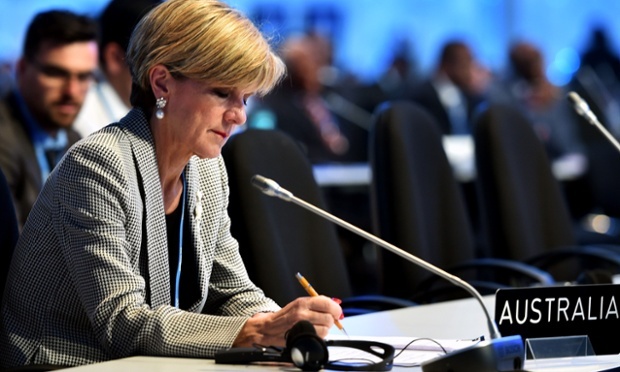Once more the government shows its skill in avoiding real issues. [16 December 2014 | Boyer]
What is a stable climate worth? What price should each country pay in the global effort to get greenhouse gases down to a level that will allow our grandchildren to enjoy the climate we did?

Australian foreign minister Julie Bishop at the 20th UNFCCC meeting in Lima, Peru. PHOTO GUARDIAN AUSTRALIA
The answer depends on how you measure it.
It’s clear that each of the big national emitters has to be part of the solution. In recent years these have been China (nearly a quarter of global emissions), the US (around 16 per cent) and the European Union with 11 per cent.
Of other major emitters, India’s contribution is 6 per cent and growing. Russia’s is nearly that, with the rest of the top 10 made up of Japan, Brazil, Indonesia, Canada and Iran. Australia comes in at 14th with a modest 1.3 per cent of the total.
Responsibility at a personal level is another story. Australia’s per-capita emissions are higher than those of any other G20 country and 2½ times those of China, putting us in the same league as inefficient rust-belt economies and profligate Middle East oil sheikdoms.
Another measure is the ratio of a country’s emissions to its economic output. Australia is about half-way down the list. We’re more efficient than Russia, China and India and about the same as Israel and South Korea, but we’re behind Canada and the US, and well behind Europe, Japan and our neighbour across the Tasman, New Zealand.
Then there’s historical emissions. In global diplomacy this measure gives an advantage to developing countries such as China, India and Brazil, so it tends to get ignored by the leaders of richer countries, including Australia.
But it’s not without merit. Carbon dioxide molecules can remain in the atmosphere for many centuries. Emissions from the start of the Industrial Revolution still affect our climate today and will do so for centuries more.
Over those 270-odd years, accumulated emissions from developed economies including Europe, North America, Japan and Australia add up to nearly three-quarters of the global total.
The remainder includes China and India. While they stand to lose enormously from global warming, their total historical contribution to it remains small compared with developed countries, so they have held back on making tough commitments.
But it’s complicated. For example, China’s booming economy gives scope to cut emissions more, while former Soviet states with historically high emissions have much less capacity to do so.
This is by way of a backdrop to the appearance at the 20th formal UN climate meeting in Lima last week of foreign minister Julie Bishop and her “chaperone”, trade minister Andrew Robb. The internal politics behind that arrangement is interesting, but that’s another story.
Historical emissions don’t wash with Bishop. She told delegates not to distinguish developing from developed countries, and that China and India needed to stop using their developing status as an excuse not to put in more effort to cut emissions.
She also pulled $A200 million ($US166 million) from her foreign aid kitty to put into the Green Climate Fund to help poorer countries deal with climate change, despite Tony Abbott’s earlier refusal to have anything to do with what he called the Bob Brown Bank. More interesting politics.
But banish any thought that Australia might lead by example. Bishop said Australia won’t set up a post-2020 target until our trading partners have announced theirs. Robb even intimated that if trading partners didn’t pull their weight we’d opt out altogether.
Climate, however, doesn’t wait for politics. The sense of urgency that keeps finding its way into these meetings came this year in the form of the UN Environment Program’s fifth annual Emissions Gap Report, released as the Lima meeting started.
There’s no precise danger line for global warming, but it will certainly be dangerous when the world’s mean surface temperature is 2C above pre-industrial levels. In 2010 governments including Australia pledged to stay below that line. We’re now nearly halfway there and closing fast.
The Emissions Gap Report says that if we’re to stay under 2C, by around 2060 global carbon dioxide emissions will need to be balanced by CO2 uptake (carbon neutrality) and by around 2090 the same will have to apply to all greenhouse gases including methane and nitrous oxide.
Within about 15 years global emissions will need to be more than 10 per cent below 2010 levels, and by 2050 will need to be less than half those in 2010. Postponing stringent cuts, the report says, will carry big social risks and cost more. By which you should read: be beyond our means.
Without stronger policies, the report says, in coming decades global greenhouse gas emissions “will increase hugely”. It points out that Australian emissions have risen since carbon pricing ended in July, and says we’re now on track to reach 2020 nearly 30 per cent above our very modest target.
The politics go on regardless. Despair seems appropriate, but despair is not an option.
